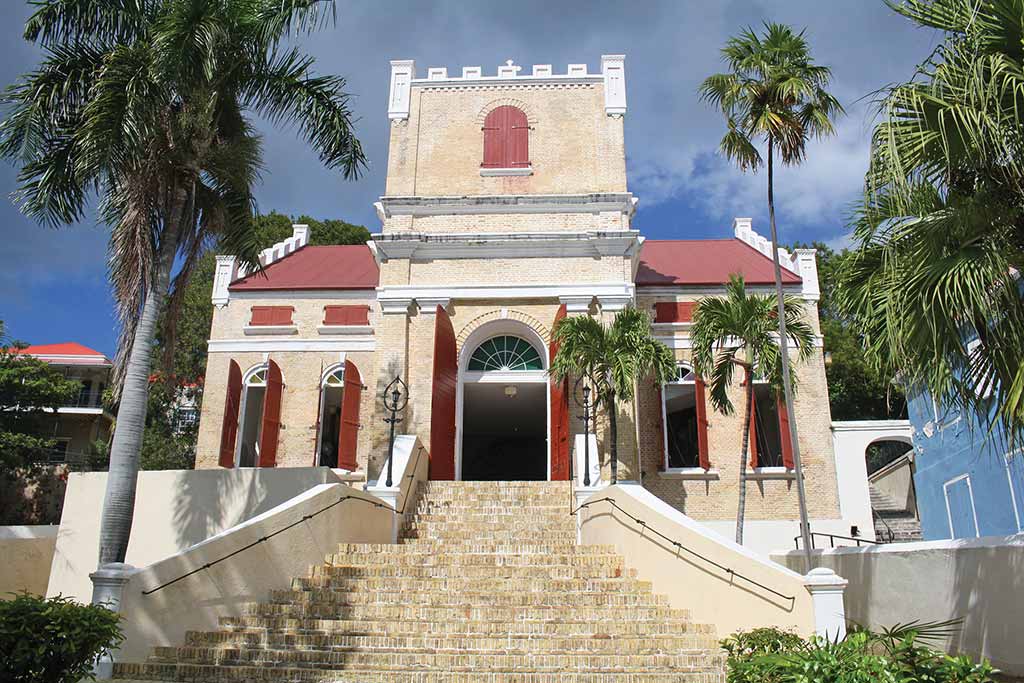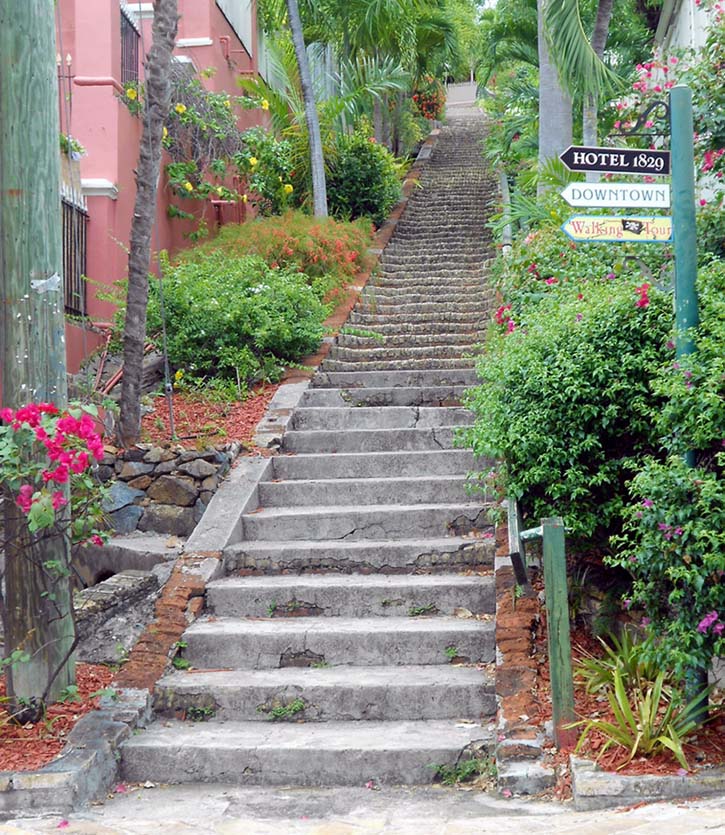The best way to experience Charlotte Amalie’s historic charm is to explore the area around Government Hill in the western area of King’s Quarter. Divided into three kvarters (quarters) by the Danes, the oldest part of Charlotte Amalie is King’s Quarter, also known as Kongens Quarter, where the earliest government buildings, stately homes, churches, and the island’s first hospital were built.
Don’t miss Sights in King’s Quarter, Part 1.
Across Norre Gade (Main Street) from the Grand Galleria is Frederick Lutheran Church, the earliest church still standing on St. Thomas. Work began on Frederick Lutheran Church in the 1780s, and it was dedicated in 1793. The original church was in the simple Georgian style. It was gutted by fire in 1825 and rebuilt, with the addition of some Gothic-style trim. An 1870 hurricane blew off the roof, which was rebuilt. Inside you will see a large mahogany altar and mahogany pews—each with its own door.

Frederick Lutheran Church on St. Thomas. Photo © Susanna Henighan Potter.
Lutheranism was the official religion of the Danish colony, and while other faiths were tolerated, Lutheranism was encouraged. During the period of slavery, ministers led two services on Sunday: one for the Danish and one for people of color.
Take one of the narrow steep walks up to white-brick Government House, the fourth official residence of the Virgin Islands’ chief executive, now used only for offices. (The governor lives at Catherineberg, atop Denmark Hill.) Built in 1867 by St. Croix carpenter Richard Bright, the house was designed by a local merchant, Otto Marstrand, and is notable for its covered balconies with slender fluted columns and ironwork rails. Inside is a handmade mahogany staircase. Ask at the security desk if you can come in for a look around.
Tucked along a narrow alley next to the lieutenant governor’s office on Government Hill is the Seven Arches Museum (Knud Hansen Alley, 340/774-9295, appointment only, $7) within a historic home. This spot was first surveyed in 1805; early structures were destroyed by hurricanes in the first half of the 19th century. Italian Andre Bonelli constructed the present building in 1857 as a gift to his daughter. The museum is furnished with antique West Indian mahogany furniture.

The 99 steps (count them, there’s a few more actually!) lead to Blackbeard’s Castle. Photo © Roger W, licensed Creative Commons Attribution Share-Alike.
Step-streets are one of Charlotte Amalie’s most distinctive features, and the most famous of these is 99 Steps, a narrow steep walkway originating between Hotel 1829 and the Lutheran Parsonage. The walk connects Government Hill with Trygborg, a Danish lookout tower that dates back to 1680 and is better known today as Blackbeard’s Castle. As you’ll discover if you care to count, the steps are wrongly named: There are more than 100.
Less well known but no less beautiful, the bright white step-street that is a continuation of Lille Taarne Gade rises between Government House and the Lutheran Parsonage.
A Danish lookout tower dating from 1680, Trygborg, better known today as Blackbeard’s Castle, is the centerpiece of a collection of historic buildings and museums clustered around Government Hill. Access to these privately owned buildings is through Blackbeard’s Castle (340/776-1234, 9am-2pm Tues.-Wed., $10), which offers a self-guided walking tour of four historic homes as well as the Trygborg tower itself. Opening hours vary according to the seasons; call ahead to confirm.
Tour stops include Villa Notman, built in 1860 by Scottish engineer James Notman; Britannia House, the onetime home of the British consul to the Danish West Indies; Haagensen House, an 1827 home built for the Danish banker Hans Haagensen; and Hotel 1829, formerly the Lavalette House and a functioning hotel. Each of the historic homes has been restored with period furniture and decor, and most days you can finish your tour with a refreshing beverage at Hotel 1829’s antique bar. The Blackbeard’s Castle tour also includes several opportunities to buy pirate and rum-themed souvenirs along the way.
Excerpted from the Sixth Edition of Moon U.S. & British Virgin Islands.